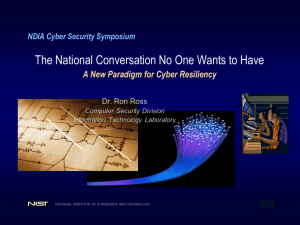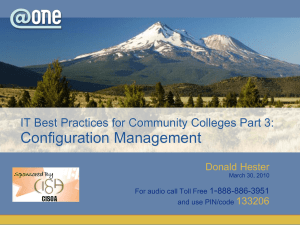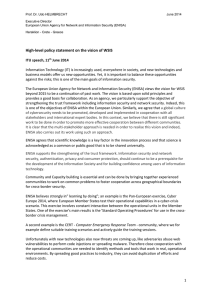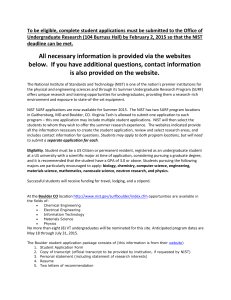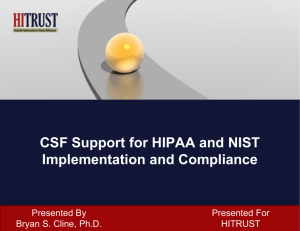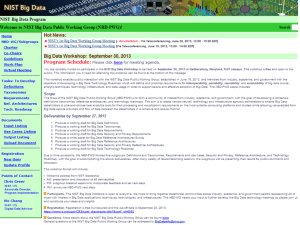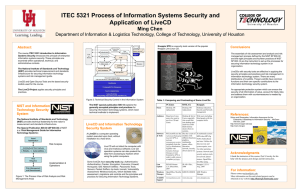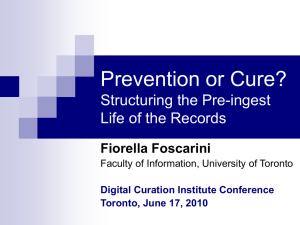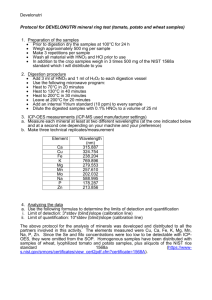Jing_Zhang
advertisement
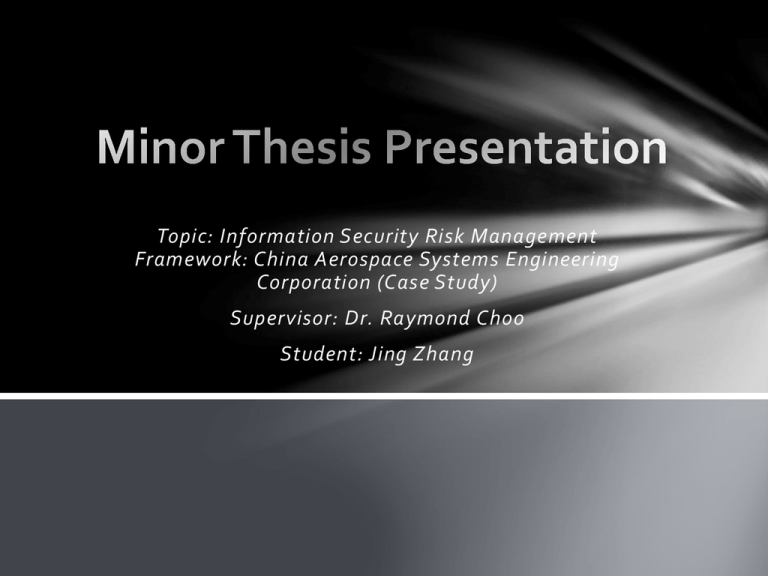
Topic: Information Security Risk Management Framework: China Aerospace Systems Engineering Corporation (Case Study) Supervisor: Dr. Raymond Choo Student: Jing Zhang Presentation outline Background Research question Literature founding Case study • Threat landscape • Risk framework (Case study company) • Comparison and improvement Conclusion Background Cybercrime influence faced by company 75 billion USD financial losing each year in United States Target: E-commerce, sensitive information Attack type: E-mail spoofing, phishing, malware installation, etc. Reason: counterfeit software, employee security awareness, etc. Research questions What are the (cyber) threat landscape and the emerging trends and challenges that would have an impact on the China Aerospace Systems Engineering Corporation (Case Study Company)? What are the limitations of existing information security risk management frameworks and/or how can existing frameworks be adapted in the Case Study Company? Literature finding Three international risk management frameworks: NIST sp800-30 (National institute of Standard and Technology) USA ISO 31000 (International Organization for Standardization) Australia ENISA (European Network and Information Security Agency) European country Literature finding (Cont’d) Terminology and risk management phases NIST sp800-30 First phase ISO 31000 ENISA Mandate and commitment Corporate risk management strategy Design of framework for managing risk Second phase Risk assessment Risk mitigation Implementing risk management Risk assessment Risk treatment Risk acceptance (optional) Third phase Evaluation and assessment Monitoring and review of the framework Continual improvement of the framework Monitoring and review Literature finding (Cont’d) NIST sp800-30 Literature finding (Cont’d) ISO 31000 Literature finding (Cont’d) ENISA Case study Threat landscape • Phishing: online shopping, ticket selling, travelling agency, Internet banking • Mobile device attacking: steal Email account, mobile banking information, unauthorised charging fee (premium SMS) • Advanced Persistent Threat (APT): enterprise level attack, more specific target, sensitive information. Case study (Cont’d) Risk framework (Case study company) Risk management process: risk identification, risk analysis, risk treatment, control implementation, risk monitoring and control improvement, communication • Risk identification: information assets (system, software, hardware, employee and archived data) Threat (Non-human, human) vulnerability (technical, operational, management) • Risk analysis: Likelihood (attraction level of each information asset) and consequence (financial: both information value and recovery cost) Case study (Cont’d) Risk framework (Case study company) • Risk treatment: Control method: Risk avoidance, Risk transformation, Risk minimisation, Risk acceptance Control category: Technical control, Operation control, Management control Cost benefit analysis: Purchase cost, Continuing cost, Employee training cost • Control implementation Implementation report: timeline, responsibility • Risk monitoring and control improvement new risk treatment plan after review and monitoring • Communication Case study (Cont’d) Risk framework (Case study company) Implementation plan: Planning and preparation, Deployment and implementation, Monitoring and improvement • Planning and preparation: Achieve the support: senior management team, related department (human, physical, financial and timing support) Main processor and responsibility: information security team, IT group, Human resources, Financial department Security control selection and implementation: Economic factor, Timing factor, Technical factor, Control implementation plan Case study (Cont’d) Risk framework (Case study company) • Deployment and implementation Security training: User training, Manager training, Security staff training • Monitoring and improvement Mitigation plan: Internal and external network data exchange policy, Security auditing, Accessing control, etc. Case study (Cont’d) Comparison and improvement: What feature missed in company framework: • Context establishment (ISO 31000 and ENISA), system characterization (NIST), risk criteria (ISO) • Motivation analysis (NIST), organisation processor, stakeholder concern and expertise decision, organisation risk attitude and tolerance (ISO 31000, ENISA) • Cost benefit (NIST): implementing effect, non-implementing effect, implementing cost • Positive risk (ENISA) • Risk assessment and mitigation activity (NIST) • Residual risk (all three frameworks) Conclusion • Different perspective in some fields • Still could improvement • Risk management is vital in organisation activity Reference E. G. Amoroso, "Cyber attacks: awareness," Network Security, vol. 2011, pp. 10-16, 2011. E. E. Anderson and J. Choobineh, "Enterprise information security strategies," Computers & Security, vol. 27, pp. 22-29, 2008. K. K. R. Choo, "Cyber threat landscape faced by financial and insurance industry." Trends and Issues in Crime and Criminal Justice 408: 1-6, 2011. B. Kakoli, P. Peter, K. M. Mykytyn, "A framework for integrated risk management in information technology", Management Decision, vol. 37 no: 5, pp.437 – 445, 1999. M. Burdon, B. Lane, and P. von Nessen, "The mandatory notification of data breaches: Issues arising for Australian and EU legal developments," Computer Law & Security Review, vol. 26, pp. 115 -129, 2010. K.K. R. Choo, "The cyber threat landscape: Challenges and future research directions," Computers & Security, vol. 30, pp. 719-731, 2011. G. Locke, P. D. Gallagher, “Guide for applying the risk management framework to federal information system: a security life cycle approach”, NIST Special Publication 800-37, 2010. Standard. A and Standard. N. Z, “Risk management”, Standard Australia and Standard New Zealand, AS/NZS 4360:2004, 2004. N. I. S. A. European, “Risk Management: Implementation principles and Inventories for Risk Management/Risk Assessment methods and tools”, European Network and Information Security Agency, 2006. G. Stoneburner, A. Goguen, et al. "Risk management guide for information technology systems" NIST special publication 800(30): 800–830, 2002. Question?
